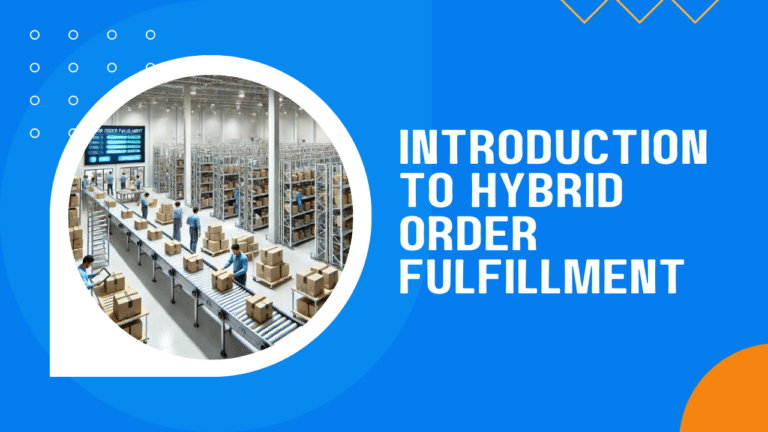Efficient order fulfillment is crucial for the success of any ecommerce business. It directly impacts customer satisfaction, operational costs, and overall business scalability. Traditionally, companies relied on a single method to handle order fulfillment, but as ecommerce evolves, so does the need for more flexible and efficient solutions. This is where hybrid order fulfillment models come into play.
Hybrid order fulfillment combines multiple fulfillment strategies—such as in-house fulfillment, third-party logistics (3PL), dropshipping, and store fulfillment—to create a robust and adaptable system. By leveraging the strengths of different methods, businesses can optimize their operations, reduce costs, and meet varying customer demands effectively.
In this article, we will explore the foundational concepts of hybrid order fulfillment. We’ll define what hybrid order fulfillment is, explain its growing importance in ecommerce, and discuss the key benefits it offers, including increased flexibility, cost efficiency, improved customer satisfaction, and scalability. Additionally, we will explore the core components of a hybrid order fulfillment system, setting the stage for a deeper understanding of how this model can transform your business operations.
What is Hybrid Order Fulfillment?
Hybrid order fulfillment is a strategy that combines multiple fulfillment methods to create a flexible, efficient, and scalable logistics system. By integrating different approaches such as in-house fulfillment, third-party logistics (3PL), dropshipping, and store fulfillment, businesses can optimize their operations to better meet diverse customer needs.
By combining these approaches, businesses can achieve greater flexibility, cost efficiency, and improved customer satisfaction, making hybrid fulfillment a powerful strategy for modern retail and ecommerce operations.
Benefits of Hybrid Order Fulfillment Models
Hybrid order fulfillment models offer several advantages that enhance the efficiency and effectiveness of ecommerce operations. By leveraging the strengths of multiple fulfillment methods, businesses can achieve a range of benefits that contribute to their overall success.
Increased Flexibility
Hybrid fulfillment models provide the flexibility to adapt to varying market conditions and customer demands. Businesses can easily switch between different fulfillment methods based on factors like order volume, product type, and customer location. This adaptability ensures that operations remain efficient and responsive, even during peak seasons or unexpected surges in demand.
Cost Efficiency
By combining different fulfillment strategies, businesses can optimize costs across their supply chain. In-house fulfillment allows for control over handling and packaging expenses, while 3PL providers offer scalable solutions that reduce the need for significant upfront investments in infrastructure. Dropshipping eliminates storage costs, and store fulfillment minimizes shipping expenses by using existing inventory. This cost optimization leads to better profit margins and overall financial health.
Improved Customer Experience
Hybrid models enhance customer satisfaction by offering multiple fulfillment options, such as faster shipping times and convenient in-store pickups. Customers can choose the method that best suits their needs, leading to a more personalized and satisfying shopping experience. Additionally, the ability to fulfill orders quickly and accurately reduces the likelihood of delays and errors, further boosting customer loyalty and retention.
Scalability
One of the key advantages of hybrid fulfillment is its scalability. Businesses can easily scale their operations up or down based on demand without overextending their resources. 3PL providers and dropshipping partners can handle large volumes of orders during peak periods, while in-house and store fulfillment can be used for more controlled and customized processes. This scalability ensures that businesses can grow and adapt without compromising service quality.
Risk Mitigation
Diversifying fulfillment methods helps mitigate risks associated with supply chain disruptions. If one fulfillment method faces challenges, businesses can rely on alternative strategies to maintain continuity. For example, if a warehouse experiences delays, dropshipping or store fulfillment can be used as backup options. This risk diversification strengthens the resilience of the supply chain and ensures consistent service delivery.
By implementing hybrid order fulfillment models, businesses can leverage these benefits to create a more robust, efficient, and customer-centric operation. This strategic approach not only optimizes logistics and reduces costs but also positions companies to better navigate the dynamic landscape of ecommerce.
Components of Hybrid Order Fulfillment
Hybrid order fulfillment models integrate various fulfillment methods to create a comprehensive and adaptable logistics system. The key components of these models include in-house fulfillment, third-party logistics (3PL), dropshipping, and store fulfillment. Each component plays a distinct role in optimizing the supply chain and enhancing customer satisfaction.
In-House Fulfillment
In-house fulfillment involves managing warehousing, inventory, and order processing within the company. This method provides direct control over the entire fulfillment process, ensuring quality and consistency in packaging and shipping. Businesses can tailor their operations to meet specific product requirements and customer expectations. In-house fulfillment is particularly advantageous for high-margin products, customized items, or brands that prioritize maintaining a strong brand image through every step of the order fulfillment process.
Third-Party Logistics (3PL)
Third-party logistics providers offer outsourced fulfillment services, including warehousing, picking, packing, and shipping. Utilizing 3PL allows businesses to benefit from the expertise, technology, and infrastructure of specialized logistics companies without significant capital investment. This component is highly scalable, making it ideal for handling fluctuations in order volume and expanding into new markets. By partnering with 3PL providers, businesses can focus on core operations while ensuring efficient and reliable fulfillment.
Dropshipping
Dropshipping is a fulfillment method where products are shipped directly from the supplier to the customer, bypassing the need for the business to hold inventory. This component is cost-effective as it eliminates the need for warehousing and reduces the risk of unsold stock. Dropshipping is suitable for businesses that offer a wide range of products or want to test new products without upfront investment. It also allows for a quick response to market trends and customer demands, enhancing product availability and variety.
Store Fulfillment
Store fulfillment, also known as Buy Online, Pick Up In-Store (BOPIS), utilizes existing brick-and-mortar stores to fulfill online orders. This method reduces shipping times and costs by leveraging local inventory, providing customers with faster and often same-day delivery options. Store fulfillment enhances the omnichannel shopping experience, allowing customers to choose convenient pickup locations and times. Additionally, it helps retailers maximize the use of their store inventory and increase foot traffic to physical locations.
By integrating these components, hybrid order fulfillment models create a versatile and resilient fulfillment system. Each method complements the others, enabling businesses to optimize their operations, reduce costs, and meet diverse customer needs effectively.
Conclusion: Embracing the Power of Hybrid Order Fulfillment
Hybrid order fulfillment is transforming the e-commerce landscape, offering businesses the flexibility and efficiency needed to meet the demands of today’s consumers. By integrating various fulfillment methods—such as in-house fulfillment, third-party logistics (3PL), dropshipping, and store fulfillment—businesses can optimize their operations to handle diverse customer needs, reduce costs, and enhance overall efficiency.
In this article, we explored the foundational concepts of hybrid order fulfillment, from defining its key components to understanding its significant benefits. By adopting a hybrid fulfillment model, businesses can achieve increased flexibility, cost efficiency, improved customer satisfaction, and scalability, positioning themselves to effectively respond to market fluctuations and growth opportunities.
As the ecommerce industry continues to evolve, embracing hybrid order fulfillment will be crucial for businesses aiming to stay competitive and deliver exceptional service. Leveraging the strengths of multiple fulfillment methods, businesses can ensure sustainable growth and operational excellence in a dynamic marketplace. This strategic approach not only addresses the complexities of modern consumer expectations but also sets the stage for long-term success in the digital age.









